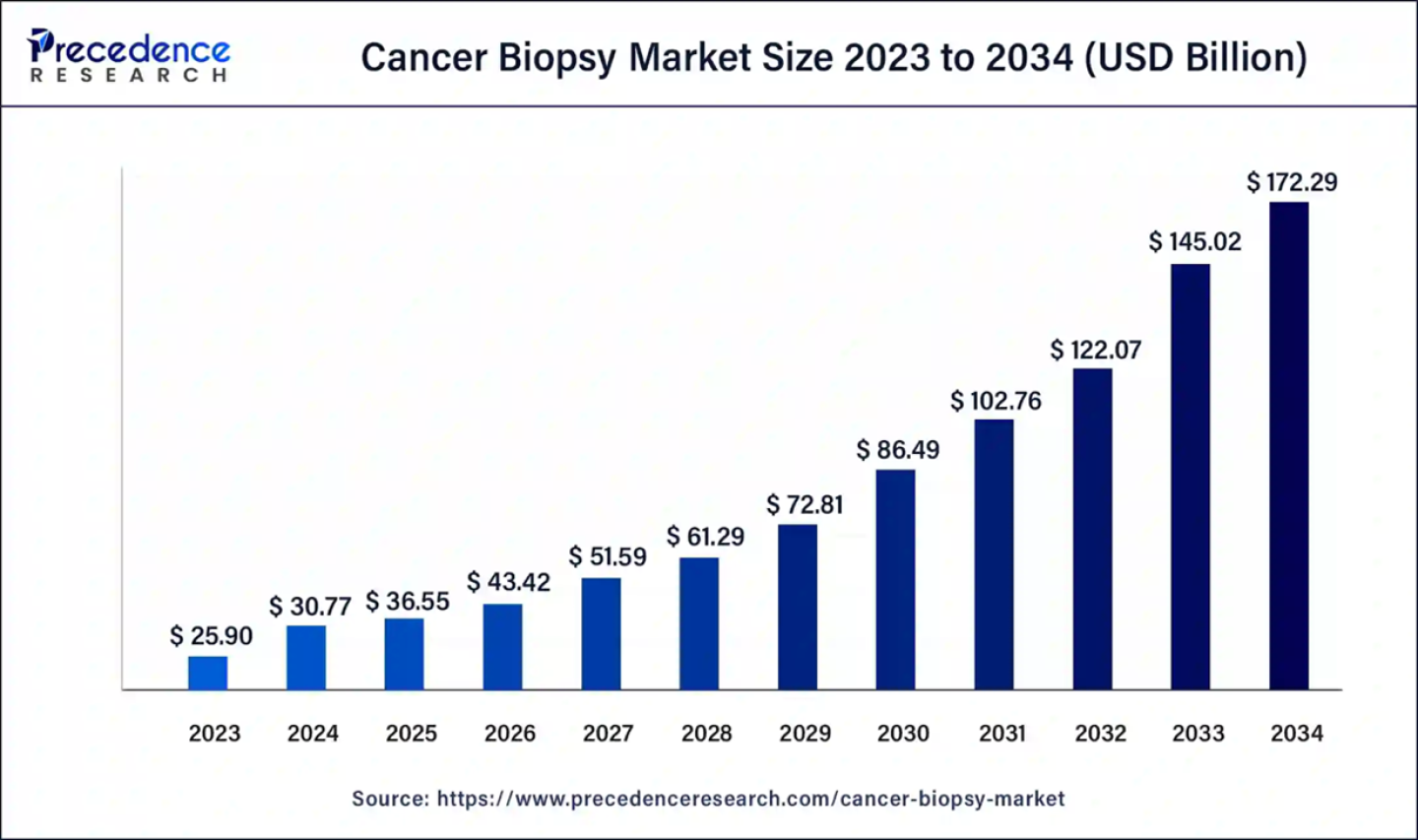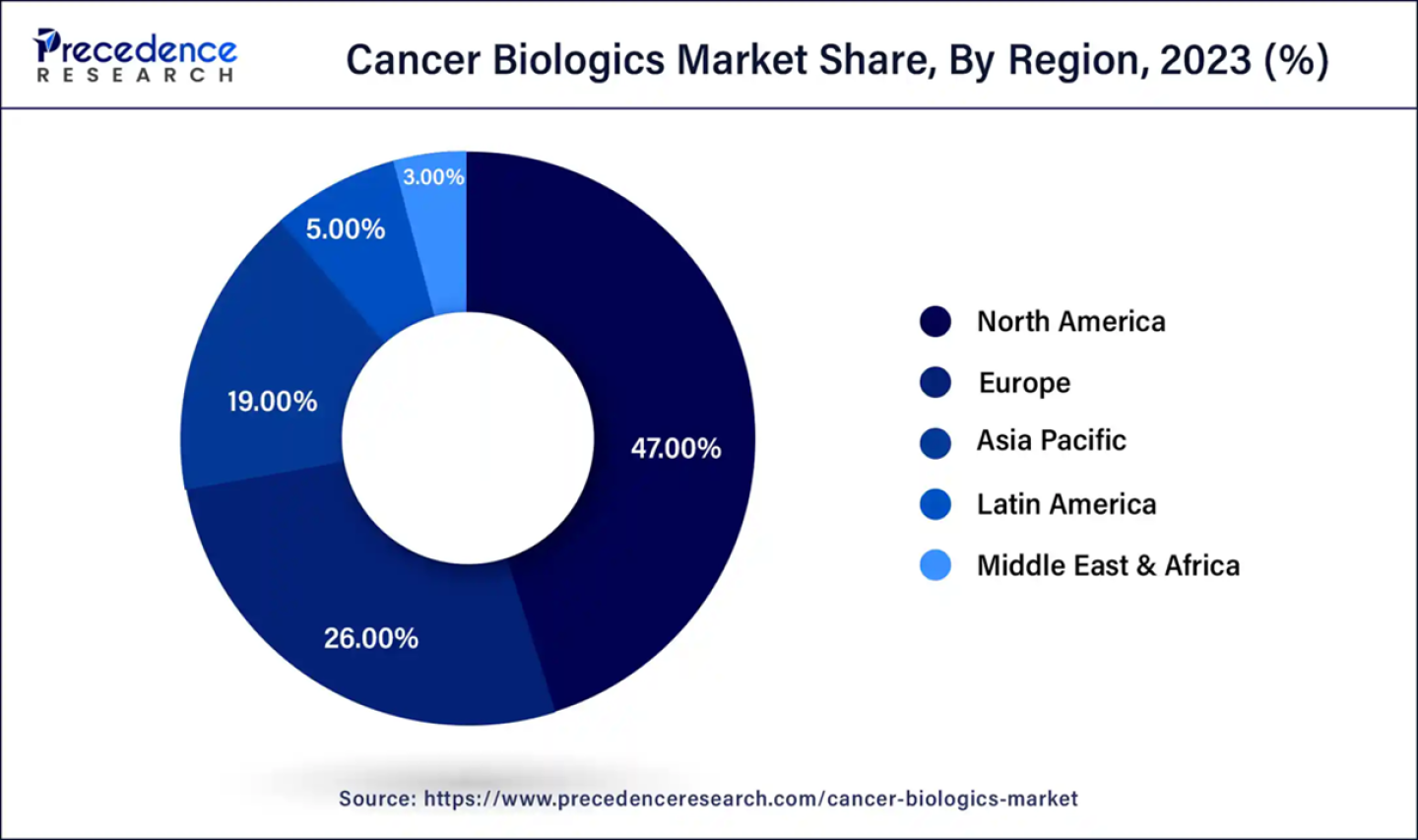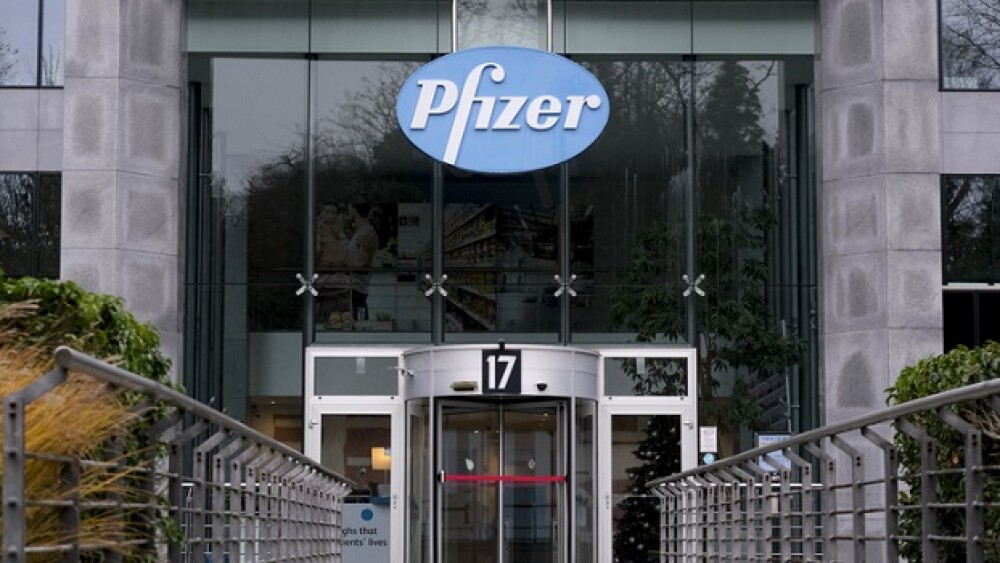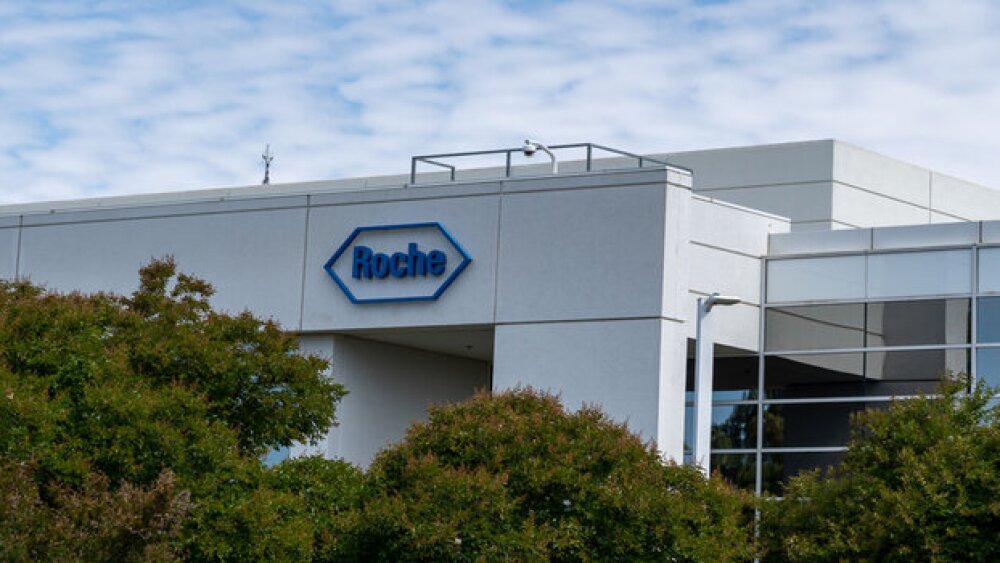According to Report, the global cancer biopsy market size was evaluated at US$ 25.90 billion in 2023 and is expected to attain around US$ 172.29 billion by 2034, growing at a CAGR of 18.8% from 2024 to 2034. The U.S. cancer biopsy market size is expected to hit around USD 50.60 billion by 2034 and growing at a CAGR of 19% from 2024 to 2034.
FREE sample includes data points, ranging from trend analyses to estimates and forecasts@ https://www.precedenceresearch.com/sample/1514
The biopsy results play a crucial role in enabling healthcare providers to determine the malignancy of cells, pinpoint the cancer's origin, and identify its specific type. A biopsy aids in assessing the aggressiveness of the cancer, referred to as the cancer. This essential diagnostic capability significantly contributes to the growth of the cancer biopsy market, as it highlights the importance of accurate and early detection in effective cancer treatment and management.
Cancer Biopsy Market Overview
The cancer biopsy market is experiencing rapid growth due to the critical role biopsies play in cancer diagnosis and treatment. A biopsy involves taking a tissue sample to be examined under a microscope, providing the only definitive method to determine if an abnormal area is cancerous. This procedure not only identifies the presence of cancer but also provides vital information about the type of cancer and its growth rate. Biopsies, which can be performed on almost any part of the body, are essential for diagnosing cancer, as well as differentiating it from other conditions. The method of sample removal varies depending on the location and type of suspected cancer, as well as the purpose of the biopsy. This increasing reliance on biopsies for accurate diagnosis and personalized treatment plans is a key driver behind the expansion of the cancer biopsy market.
· In April 2023, Quest Diagnostics announced its acquisition of Haystack Oncology, adding sensitive liquid biopsy technology to enhance personalized cancer care within its oncology portfolio.
· In April 2023, the FTC ordered Illumina to divest cancer detection test maker GRAIL to protect competition in the life-saving technology market.
Report Highlights
· North America has accounted highest market share of around 47% in 2023.
· By type, the tissue biopsy segment is expected to garner the biggest revenue share in 2023.
· By type, the liquid biopsy segment is poised to grow at a notable CAGR between 2024 and 2034.
· By product, the kits and consumables segment has accounted market share of 61% in 2023.
· By application, the breast cancer segment is projected to hold the largest market share in 2023.
Get Full Access of this Report@ https://www.precedenceresearch.com/checkout/1514
What are the top trends in Cancer Biopsy Market?
North America leads the cancer biopsy market, with the United States alone conducting over a million breast biopsies annually. In the U.S., breast cancer is the second most common malignancy among women, following skin cancer, and is also the second leading cause of cancer-related deaths, after lung cancer. There are three primary techniques for obtaining samples from suspicious breast lesions: fine-needle aspiration, biopsy with a hollow core needle, and open surgical tissue retrieval. Approximately 20 percent of breast biopsies performed each year in the U.S. are diagnosed as cancerous, indicating that four out of five biopsies are benign. This high volume of biopsy procedures underscores the critical role of advanced diagnostic techniques in the region and drives the robust growth of the cancer biopsy market in North America.
Asia-Pacific is poised to experience the fastest growth in the cancer biopsy market during the forecast period. The region is projected to lead in healthcare spending, accounting for over 20% of global expenditure by 2030. This surge is driven by consumers who are taking greater ownership of their health and are willing to invest more in healthcare services. Approximately 50% of all consumers, and 58% of Gen Z, plan to increase their healthcare spending in exchange for improved health outcomes, enhanced experiences, and greater efficiency. Additionally, there is a growing demand for convenience in healthcare delivery among consumers in Asia-Pacific, further propelling the market's rapid expansion.
We value your investment, get customization@ https://www.precedenceresearch.com/customization/1514
Report Highlights
By Type
Tissue biopsies hold the highest market share in the cancer biopsy sector. This procedure involves the removal of tissue from any part of the body for disease examination. Techniques vary, with some using a needle to extract a small tissue sample and others surgically removing a suspicious nodule or lump. Most needle biopsies are minimally invasive and performed on an outpatient basis. In contrast, liquid biopsies, which are blood tests detecting cancerous tumors, identify circulating tumor fragments in the bloodstream. Both types are integral to cancer diagnosis, but tissue biopsies remain the dominant method due to their widespread use and established diagnostic accuracy.
The liquid biopsy segment is the fastest-growing sector within the cancer biopsy market. This innovative blood test detects signs of cancerous tumors, including tumor cells and cancer cell DNA. Current U.S. FDA-approved liquid biopsy tests can identify certain types of advanced cancers, predict prognosis, and assist healthcare providers in making informed treatment decisions. Ongoing research aims to expand the applications of liquid biopsy tests, further enhancing their utility and driving rapid growth in this segment.
By Product
The kits and consumables segment dominates the cancer biopsy market, with tissue biopsy kits being widely used for the preservation and transport of tissue samples for testing. These kits ensure the integrity and viability of samples from collection to laboratory analysis, making them essential for accurate diagnostic processes and driving the segment's leading market position.
The instruments segment is projected to grow rapidly over the forecast period in the cancer biopsy market. Essential tools such as thin guide wires, marking dyes, syringes, sponges, forceps, scalpels, and specimen cups or microscope slides are crucial for accurately locating and collecting tissue samples for pathological examination. Utilizing x-ray, ultrasound, or CT guidance enhances precision in surgical biopsies. This array of biopsy equipment is vital for the manual collection of tissue samples, contributing significantly to the segment anticipated robust development.
By Application
The breast cancer segment dominates the cancer biopsy market. Core needle biopsy (CNB), which uses a larger hollow needle to sample breast changes identified through physical examination, ultrasound, mammogram, or MRI, is often the preferred method when breast cancer is suspected. This procedure is essential for confirming a breast cancer diagnosis when symptoms or imaging test results, such as those from a mammogram, indicate potential malignancy. The prevalence and critical nature of breast cancer diagnosis drive the dominant position of this application segment in the cancer biopsy market.
The prostate cancer segment is expected to develop at the fastest rate in the coming years. A prostate biopsy involves removing samples of suspicious tissue from the prostate, a small, walnut-shaped gland in males that produces fluid to nourish and transport sperm. During the procedure, a needle is used to collect multiple tissue samples from the prostate gland. The increasing prevalence of prostate cancer and advancements in biopsy techniques are driving the rapid growth of this application segment in the cancer biopsy market.
Market Dynamics
Driver
Rising Cancer Incidence
The rising incidence of cancer is a key driver of the cancer biopsy market. In the coming year, the U.S. is anticipated to see a significant milestone with new cancer cases surpassing 2 million, translating to nearly 5,500 diagnoses daily. This increase is primarily influenced by an aging population and a surge in diagnoses of six of the top ten cancers breast, prostate, endometrial, pancreatic, kidney, and melanoma. With projections of over 611,000 cancer-related deaths in the U.S. in 2024, equating to more than 1,600 deaths per day, there is a heightened demand for advanced diagnostic solutions, further fueling the growth of the cancer biopsy market.
Restraint
Cost and Inconclusive
The cost of biopsy procedures varies significantly, ranging from $307 for a fine needle biopsy to $3,296 for complex surgical biopsies and up to $12,353 for other types. Specifically, biopsies involving the mediastinum average $10,554. Inconclusive diagnostic outcomes exacerbate the issue by necessitating repeat biopsies, which prolong treatment timelines, increase overall costs, and impose additional psychological stress on patients and their families. These factors contribute to constraints on the growth of the cancer biopsy market.
Opportunity
Emerging Liquid Biopsies
Traditional cancer diagnosis and characterization have largely depended on tissue biopsies, which involve sampling and laboratory processing of tumor tissue. Tissue biopsies may not capture the tumor spatial and temporal heterogeneity, which can evolve in response to treatment or external factors. This limitation highlights the need for less invasive, more convenient, and more comprehensive diagnostic methods. Liquid biopsies are emerging as a promising solution to meet this need. With several FDA-approved diagnostic tests now available to detect cancer and assess its prognosis, liquid biopsies offer valuable insights and present significant growth opportunities for the cancer biopsy market.
· In November 2023, Illumina launched an advanced liquid biopsy assay aimed at enabling comprehensive genomic profiling of solid tumors.
Related Reports
· U.S. Liquid Biopsy Market: https://www.precedenceresearch.com/us-liquid-biopsy-market
· Endomyocardial Biopsy Market: https://www.precedenceresearch.com/endomyocardial-biopsy-market
· Viral Vectors & Plasmid DNA Manufacturing Market: https://www.precedenceresearch.com/viral-vectors-and-plasmid-dna-manufacturing-market
Recent Developments
· In April 2024, SOPHiA GENETICS announced Syndicate Bio as its first liquid biopsy customer in Africa.
· In May 2024, Personalis announced the start of its cancer MRD testing commercialization collaboration with Tempus.
· In November 2023, Syantra announced a breakthrough with its liquid biopsy platform, expanded its IP portfolio, and formed a partnership with Limmi to accelerate its AI-powered RNA-based early cancer detection liquid biopsy program.
· In April 2024, Culmination Bio partnered with BillionToOne to drive diagnostic solutions in oncology.
· In June 2022, GRAIL announced a strategic collaboration with AstraZeneca to develop companion diagnostic tests to enable the treatment of early-stage cancer.
· In January 2024, Hikma and Guardant Health signed an exclusive partnership agreement to bring transformative cancer diagnostic technology to the Middle East and North Africa.
Key Players in the Cancer Biopsy Market
· Myriad Genetics Inc.
· Guardant Health Inc.
· Exact Sciences Corporation
· Bio-Rad Laboratories Inc.
· Agena Bioscience Inc.
· Personal Genome Diagnostics Inc.
· Exosome Diagnostics Inc.
· ANGLE Plc.
· F. Hoffmann-La Roche Ltd.
Market Segmentation
By Product
· Instruments
· Kits and Consumables
· Services
By Type
· Tissue Biopsies
· Fine Needle Aspiration (FNA)
· Core Needle Biopsy (CNB)
· Needle Biopsies
· Surgical Biopsies
· Liquid Biopsies
· Others
By Application
· Breast Cancer
· Colorectal Cancer
· Cervical Cancer
· Lung Cancer
· Prostate Cancer
· Skin Cancer
· Blood Cancer
· Kidney Cancer
· Liver Cancer
· Pancreatic Cancer
· Ovarian Cancer
· Others
By Geography
· North America
· Europe
· Asia Pacific
· Latin America
· Middle East & Africa (MEA)
Get Full Access of this Report@ https://www.precedenceresearch.com/checkout/1514
USA : +1 650 460 3308 | IND : +91 87933 22019 | Europe : +44 2080772818
Email@ sales@precedenceresearch.com
FREE sample includes data points, ranging from trend analyses to estimates and forecasts@ https://www.precedenceresearch.com/sample/1514
The biopsy results play a crucial role in enabling healthcare providers to determine the malignancy of cells, pinpoint the cancer's origin, and identify its specific type. A biopsy aids in assessing the aggressiveness of the cancer, referred to as the cancer. This essential diagnostic capability significantly contributes to the growth of the cancer biopsy market, as it highlights the importance of accurate and early detection in effective cancer treatment and management.
Cancer Biopsy Market Overview
The cancer biopsy market is experiencing rapid growth due to the critical role biopsies play in cancer diagnosis and treatment. A biopsy involves taking a tissue sample to be examined under a microscope, providing the only definitive method to determine if an abnormal area is cancerous. This procedure not only identifies the presence of cancer but also provides vital information about the type of cancer and its growth rate. Biopsies, which can be performed on almost any part of the body, are essential for diagnosing cancer, as well as differentiating it from other conditions. The method of sample removal varies depending on the location and type of suspected cancer, as well as the purpose of the biopsy. This increasing reliance on biopsies for accurate diagnosis and personalized treatment plans is a key driver behind the expansion of the cancer biopsy market.
· In April 2023, Quest Diagnostics announced its acquisition of Haystack Oncology, adding sensitive liquid biopsy technology to enhance personalized cancer care within its oncology portfolio.
· In April 2023, the FTC ordered Illumina to divest cancer detection test maker GRAIL to protect competition in the life-saving technology market.
Report Highlights
· North America has accounted highest market share of around 47% in 2023.
· By type, the tissue biopsy segment is expected to garner the biggest revenue share in 2023.
· By type, the liquid biopsy segment is poised to grow at a notable CAGR between 2024 and 2034.
· By product, the kits and consumables segment has accounted market share of 61% in 2023.
· By application, the breast cancer segment is projected to hold the largest market share in 2023.
Get Full Access of this Report@ https://www.precedenceresearch.com/checkout/1514
What are the top trends in Cancer Biopsy Market?
- Minimally Invasive Techniques: There is a growing preference for minimally invasive biopsy techniques, such as fine needle aspiration (FNA) and core needle biopsies, which reduce patient discomfort and recovery time. Techniques like liquid biopsies, which analyze cancer-related biomarkers in blood samples, are also gaining traction.
- Advancements in Imaging Technologies: Enhanced imaging technologies, including digital and molecular imaging, are improving the accuracy of biopsies. Innovations like MRI-guided and ultrasound-guided biopsies help in precise localization and sampling of tumor tissues.
- Liquid Biopsy: Liquid biopsies, which analyze circulating tumor DNA (ctDNA) or other biomarkers in blood, are becoming more prominent. They offer a non-invasive alternative to traditional tissue biopsies and are useful for early detection, monitoring treatment response, and identifying genetic mutations.
- Personalized Medicine: The trend towards personalized medicine is influencing the biopsy market. Biopsy results are increasingly used to tailor treatment plans based on the genetic and molecular profile of the cancer, leading to more targeted and effective therapies.
- Integration of Artificial Intelligence (AI): AI and machine learning algorithms are being integrated into biopsy analysis to enhance diagnostic accuracy and efficiency. AI can assist in analyzing biopsy samples, predicting cancer types, and assessing disease progression.
- Increased Demand for Early Detection: There is a heightened focus on early cancer detection, which drives the need for advanced biopsy techniques. Early and accurate biopsies can lead to better patient outcomes and are increasingly being incorporated into routine cancer screening programs.
- Expansion of Biopsy Types and Applications: The market is seeing a diversification of biopsy types, including more advanced techniques such as endoscopic biopsies, and biopsies for rare or complex cancers. This expansion caters to a broader range of cancer types and patient needs.
- Regulatory and Reimbursement Changes: Changes in regulations and reimbursement policies are impacting the biopsy market. As new biopsy technologies emerge, there are ongoing efforts to secure regulatory approvals and ensure that new methods are covered by insurance.
- Emerging Biomarkers and Genetic Testing: The identification of new cancer biomarkers and advances in genetic testing are shaping biopsy practices. These developments allow for more precise diagnosis and personalized treatment strategies based on specific genetic mutations.
- Patient-Centric Approaches: There is an increasing emphasis on patient-centric approaches, including minimizing the physical and emotional impact of biopsies. Efforts are being made to improve patient comfort, reduce procedure-related pain, and provide better support and information to patients undergoing biopsies.
North America leads the cancer biopsy market, with the United States alone conducting over a million breast biopsies annually. In the U.S., breast cancer is the second most common malignancy among women, following skin cancer, and is also the second leading cause of cancer-related deaths, after lung cancer. There are three primary techniques for obtaining samples from suspicious breast lesions: fine-needle aspiration, biopsy with a hollow core needle, and open surgical tissue retrieval. Approximately 20 percent of breast biopsies performed each year in the U.S. are diagnosed as cancerous, indicating that four out of five biopsies are benign. This high volume of biopsy procedures underscores the critical role of advanced diagnostic techniques in the region and drives the robust growth of the cancer biopsy market in North America.
Asia-Pacific is poised to experience the fastest growth in the cancer biopsy market during the forecast period. The region is projected to lead in healthcare spending, accounting for over 20% of global expenditure by 2030. This surge is driven by consumers who are taking greater ownership of their health and are willing to invest more in healthcare services. Approximately 50% of all consumers, and 58% of Gen Z, plan to increase their healthcare spending in exchange for improved health outcomes, enhanced experiences, and greater efficiency. Additionally, there is a growing demand for convenience in healthcare delivery among consumers in Asia-Pacific, further propelling the market's rapid expansion.
We value your investment, get customization@ https://www.precedenceresearch.com/customization/1514
Report Highlights
By Type
Tissue biopsies hold the highest market share in the cancer biopsy sector. This procedure involves the removal of tissue from any part of the body for disease examination. Techniques vary, with some using a needle to extract a small tissue sample and others surgically removing a suspicious nodule or lump. Most needle biopsies are minimally invasive and performed on an outpatient basis. In contrast, liquid biopsies, which are blood tests detecting cancerous tumors, identify circulating tumor fragments in the bloodstream. Both types are integral to cancer diagnosis, but tissue biopsies remain the dominant method due to their widespread use and established diagnostic accuracy.
The liquid biopsy segment is the fastest-growing sector within the cancer biopsy market. This innovative blood test detects signs of cancerous tumors, including tumor cells and cancer cell DNA. Current U.S. FDA-approved liquid biopsy tests can identify certain types of advanced cancers, predict prognosis, and assist healthcare providers in making informed treatment decisions. Ongoing research aims to expand the applications of liquid biopsy tests, further enhancing their utility and driving rapid growth in this segment.
By Product
The kits and consumables segment dominates the cancer biopsy market, with tissue biopsy kits being widely used for the preservation and transport of tissue samples for testing. These kits ensure the integrity and viability of samples from collection to laboratory analysis, making them essential for accurate diagnostic processes and driving the segment's leading market position.
The instruments segment is projected to grow rapidly over the forecast period in the cancer biopsy market. Essential tools such as thin guide wires, marking dyes, syringes, sponges, forceps, scalpels, and specimen cups or microscope slides are crucial for accurately locating and collecting tissue samples for pathological examination. Utilizing x-ray, ultrasound, or CT guidance enhances precision in surgical biopsies. This array of biopsy equipment is vital for the manual collection of tissue samples, contributing significantly to the segment anticipated robust development.
By Application
The breast cancer segment dominates the cancer biopsy market. Core needle biopsy (CNB), which uses a larger hollow needle to sample breast changes identified through physical examination, ultrasound, mammogram, or MRI, is often the preferred method when breast cancer is suspected. This procedure is essential for confirming a breast cancer diagnosis when symptoms or imaging test results, such as those from a mammogram, indicate potential malignancy. The prevalence and critical nature of breast cancer diagnosis drive the dominant position of this application segment in the cancer biopsy market.
The prostate cancer segment is expected to develop at the fastest rate in the coming years. A prostate biopsy involves removing samples of suspicious tissue from the prostate, a small, walnut-shaped gland in males that produces fluid to nourish and transport sperm. During the procedure, a needle is used to collect multiple tissue samples from the prostate gland. The increasing prevalence of prostate cancer and advancements in biopsy techniques are driving the rapid growth of this application segment in the cancer biopsy market.
Market Dynamics
Driver
Rising Cancer Incidence
The rising incidence of cancer is a key driver of the cancer biopsy market. In the coming year, the U.S. is anticipated to see a significant milestone with new cancer cases surpassing 2 million, translating to nearly 5,500 diagnoses daily. This increase is primarily influenced by an aging population and a surge in diagnoses of six of the top ten cancers breast, prostate, endometrial, pancreatic, kidney, and melanoma. With projections of over 611,000 cancer-related deaths in the U.S. in 2024, equating to more than 1,600 deaths per day, there is a heightened demand for advanced diagnostic solutions, further fueling the growth of the cancer biopsy market.
Restraint
Cost and Inconclusive
The cost of biopsy procedures varies significantly, ranging from $307 for a fine needle biopsy to $3,296 for complex surgical biopsies and up to $12,353 for other types. Specifically, biopsies involving the mediastinum average $10,554. Inconclusive diagnostic outcomes exacerbate the issue by necessitating repeat biopsies, which prolong treatment timelines, increase overall costs, and impose additional psychological stress on patients and their families. These factors contribute to constraints on the growth of the cancer biopsy market.
Opportunity
Emerging Liquid Biopsies
Traditional cancer diagnosis and characterization have largely depended on tissue biopsies, which involve sampling and laboratory processing of tumor tissue. Tissue biopsies may not capture the tumor spatial and temporal heterogeneity, which can evolve in response to treatment or external factors. This limitation highlights the need for less invasive, more convenient, and more comprehensive diagnostic methods. Liquid biopsies are emerging as a promising solution to meet this need. With several FDA-approved diagnostic tests now available to detect cancer and assess its prognosis, liquid biopsies offer valuable insights and present significant growth opportunities for the cancer biopsy market.
· In November 2023, Illumina launched an advanced liquid biopsy assay aimed at enabling comprehensive genomic profiling of solid tumors.
Related Reports
· U.S. Liquid Biopsy Market: https://www.precedenceresearch.com/us-liquid-biopsy-market
· Endomyocardial Biopsy Market: https://www.precedenceresearch.com/endomyocardial-biopsy-market
· Viral Vectors & Plasmid DNA Manufacturing Market: https://www.precedenceresearch.com/viral-vectors-and-plasmid-dna-manufacturing-market
Recent Developments
· In April 2024, SOPHiA GENETICS announced Syndicate Bio as its first liquid biopsy customer in Africa.
· In May 2024, Personalis announced the start of its cancer MRD testing commercialization collaboration with Tempus.
· In November 2023, Syantra announced a breakthrough with its liquid biopsy platform, expanded its IP portfolio, and formed a partnership with Limmi to accelerate its AI-powered RNA-based early cancer detection liquid biopsy program.
· In April 2024, Culmination Bio partnered with BillionToOne to drive diagnostic solutions in oncology.
· In June 2022, GRAIL announced a strategic collaboration with AstraZeneca to develop companion diagnostic tests to enable the treatment of early-stage cancer.
· In January 2024, Hikma and Guardant Health signed an exclusive partnership agreement to bring transformative cancer diagnostic technology to the Middle East and North Africa.
Key Players in the Cancer Biopsy Market
· Myriad Genetics Inc.
· Guardant Health Inc.
· Exact Sciences Corporation
· Bio-Rad Laboratories Inc.
· Agena Bioscience Inc.
· Personal Genome Diagnostics Inc.
· Exosome Diagnostics Inc.
· ANGLE Plc.
· F. Hoffmann-La Roche Ltd.
Market Segmentation
By Product
· Instruments
· Kits and Consumables
· Services
By Type
· Tissue Biopsies
· Fine Needle Aspiration (FNA)
· Core Needle Biopsy (CNB)
· Needle Biopsies
· Surgical Biopsies
· Liquid Biopsies
· Others
By Application
· Breast Cancer
· Colorectal Cancer
· Cervical Cancer
· Lung Cancer
· Prostate Cancer
· Skin Cancer
· Blood Cancer
· Kidney Cancer
· Liver Cancer
· Pancreatic Cancer
· Ovarian Cancer
· Others
By Geography
· North America
· Europe
· Asia Pacific
· Latin America
· Middle East & Africa (MEA)
Get Full Access of this Report@ https://www.precedenceresearch.com/checkout/1514
USA : +1 650 460 3308 | IND : +91 87933 22019 | Europe : +44 2080772818
Email@ sales@precedenceresearch.com






